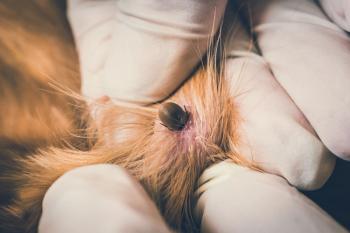
A risky side to our attachment to pets?
These days, pets are allowed almost anywhere. A recent study took a preliminary look at whether this pet-owner closeness might result in the passage of zoonotic disease.
Untitled Document
These days, pets are allowed almost anywhere. A recent study took a preliminary look at whether this pet-owner closeness might result in the passage of zoonotic disease. In March, April, and May of 2007, 159 owners of 161 healthy dogs and 63 healthy cats who visited 10 veterinary clinics in urban and rural areas in The Netherlands participated in the study. The owners completed a questionnaire that asked about their pet management routines and interactions with their pets. The researchers collected fur samples from 148 dogs and 59 cats by combing the areas people most commonly pet-the back and flank. They also examined fecal samples from 92 dogs and 22 cats brought in by the owners.
Toxocara species eggs were detected on examination of fur samples from 18 dogs (12.2%) and 2 cats (3.4%). However, none of the eggs were viable after six weeks of cultivation. And in nine of these dogs that also had their feces examined, no eggs were identified, which indicates that the presence of eggs in the fur doesn't necessarily correlate with self-contamination. Dogs, especially those allowed off leash, were significantly more likely than cats to have Toxocara species eggs in their fur. The researchers also suggested that some eggs might be transmitted via a pet owners' shoes.
Fecal examination by using a flotation-centrifugation technique revealed Toxocara species in four dogs (4.4%) and one cat (4.6%), Giardia species in 14 dogs (15.2%) and three cats (13.6%), and Cryptosporidium species in eight dogs (8.7%) and one cat (4.6%). Toxoplasma species cysts were not found in the cat feces. Although Giardia species was most prevalent, genotyping revealed that most isolates were dog- or cat-specific assemblages and that one cat and one dog were infected with a Giardia species assemblage that could be passed on to a person. The researchers state more studies are needed to establish that pets can be the source of Giardia infection for people. Cryptosporidium species genotyping was not possible, but the researchers cited other studies that indicate that cryptosporidiosis in people in relation with cats or dogs is rare.
The questionnaire identified that close physical contact between owners and pets is common and may pose an increased risk of transmission of zoonotic pathogens. Among the results reported were the following:
• 45% of dogs and 62% of cats were allowed on the owner's bed
• 45% of cats were permitted to jump onto the kitchen sink
• 50% of owners allowed their pet to lick their faces
• 55% of cat owners cleaned the litter box more than twice a week
• 39% of dog owners never picked up their dogs' feces
• 15% of dog owners and 8% of cat owners washed their hands regularly after contact with their pets
The questionnaire results also showed that 45% of the dogs and 40% of the cats were dewormed more than twice a year.
A direct link to zoonosis was not identified in this study because the pet owners were not examined for infection with these pathogens. The researchers do not consider petting a dog or cat a risk factor for acquiring a Toxocara species infection, owing in part to the number of infective eggs that must be ingested and amount of contact required with highly contaminated fur. However, good deworming schedules are needed, particularly in puppies. This study's results reveal that client education on zoonotic risks and appropriate hygiene may be in order to guard against infections in your clients.
Overgaauw PAM, van Zutphen L, Hoek D, et al. Zoonotic parasites in fecal samples and fur from dogs and cats in The Netherlands. Vet Parasitol 2009;163:115-122.
Link to abstract:
Newsletter
From exam room tips to practice management insights, get trusted veterinary news delivered straight to your inbox—subscribe to dvm360.




